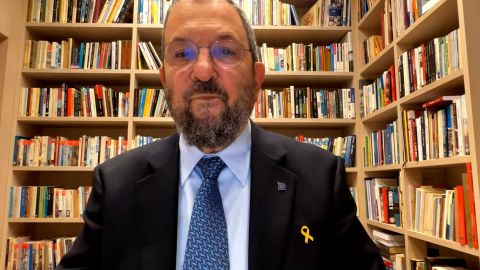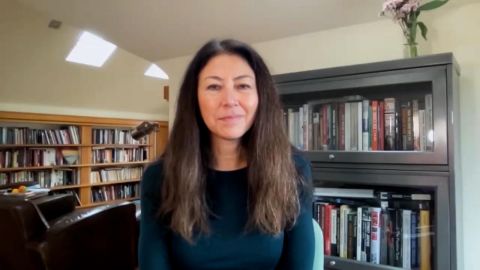Read Transcript EXPAND
CHRISTIANE AMANPOUR, CHIEF INTERNATIONAL ANCHOR: Now, while border politics and mass migration are key issues in the presidential election, back in the 1980s, candidates were getting tough on crime. Historian Reiko Hillyer traces the changes in America’s prison systems throughout the 20th century in a new book, “A Wall is Just a Wall.” And she’s joining Michel Martin to discuss the policy shift.
(BEGIN VIDEOTAPE)
MICHEL MARTIN, CONTRIBUTOR: Thanks, Christiane. Professor Reiko Hillyer, thank you so much for talking with us.
REIKO HILLYER, AUTHOR, “A WALL IS JUST A WALL” AND, ASSOCIATE PROFESSOR OF HISTORY, LEWIS & CLARK COLLEGE: Oh, it’s an honor. Thank you for having me on.
MARTIN: So, we wanted to talk about your book. It’s about clemency. So, for people who aren’t aware, like what is clemency? What does it mean?
HILLYER: Yes, I’m glad you asked. Clemency is a practice that is allowed to the executive. So, a president or a governor. And it’s the prerogative to exercise mercy. Basically, it’s the last resort for people who are incarcerated and have exhausted other means of getting out. And clemency is a demonstration that the governor recognizes that a person has changed over time and they can be safely released out into society. And so, it’s an offering of forgiveness and a shortening of a sentence.
MARTIN: So, what made you take a look at clemency and how it’s changed over the years? And I think the big — honestly, you know, the headline of the book, it’s changed a lot, you know, over the years. What made you take a look at it?
HILLYER: Well, it seems to me that if we understand mass incarceration, a very quick way of saying it is that we incarcerate way too many people for way too long. And this has been possible in large part because we’ve been convinced that people who’ve committed very violent acts are permanently dangerous. And we’ve made them invisible. And so, we can be persuaded of this sort of fear mongering ideas. But in fact, our ideas about who poses a violent threat, how long a murder sentence should be, how much interaction an incarcerated person should have with the free world, those are all ideas that have changed radically over time. And I’m looking at time periods when there was a different kind of common sense when governors use their clemency powers much more robustly. And the decline of the use of clemency has resulted in the mass imprisonment of people for very extreme sentences who are ready to get out.
MARTIN: So, how did the idea of sort of clemency in the United States kind of come to be? Was it always a part of our criminal justice system?
HILLYER: The founding fathers recognized that all of our systems of governance were ultimately fallible because they’re created by human beings. And the idea that an executive should be able to exercise mercy was seen as a check on all of those systems. It was a very recognition of a human need to rectify mistakes. And it was — it’s in the federal constitution, and it’s in every single state constitution. And for over, you know, 200 years, governors recognize and use this power relatively frequently. In the Jim Crow South, it was exercised all the time. Governors would release hundreds of people at the ends of their terms. And of course, that was in the context of white supremacy. So, there were other mechanisms to keep people in their place. If you know what I mean. But it wasn’t just in the Jim Crow South. In Oregon, in the 1890s, a governor released basically a quarter of the prison population at the end of his term. In New York, governors have used clemency throughout the 1960s and ’70s, mostly for people who have been convicted of murder in Louisiana. For most of the 20th century, it was understood that a life sentence did not mean life and that if a person conducted themselves well in prison and demonstrated some personal growth that the warden would recommend him for clemency and the governor would basically rubber stamp it. And this was routine for about 75 years in Louisiana.
MARTIN: One of the reasons that we found you is that you wrote an op-ed for the “Boston Globe” pointing up something that the governor of Massachusetts, Maura Healey, has proposed making the clemency system more expansive. You know, taking into account things like the age that a person was when an offense was committed, how the person has conducted himself or herself in — while incarcerated and things of that sort. And one of the things you pointed out is that this is not exactly new. This is actually a return to the way things used to work. So, what changed? How did it become that — I mean, you point out that, you know, governors, even in so-called sort of progressive states, very rarely use the clemency process today. What changed?
HILLYER: Well, in the 1990s, as you’re probably aware, there’s a wave of so-called tough-on-crime legislation and a kind of hunger for a more punitive approach to incarceration, replacing rehabilitation with harsh punishment. And this is the era of mandatory minimums and truth in sentencing. And it’s also an era of lots of anti-welfare rhetoric and a lot of sort demonizing of the racialized poor and of drug users. And so, the idea that people could be released early was something that was portrayed as an undue risk. And this was basically a successful propaganda campaign based on sensationalizing very exceptional cases. For example, the Willie Horton case or the William Horton case of the late 1980s.
MARTIN: Would you just go back and describe what would happen? I mean, obviously, for people who cover presidential campaigns, they realize it loomed very large in the campaign between, you know, then-Vice President George H .W. Bush and then-Massachusetts Governor Michael Dukakis.
HILLYER: Yes. So, William Horton was one of thousands of people who was released from a Massachusetts state prison facility in the late 1980s on a furlough program that was extended to even people serving life without parole. William Horton was someone who actually did work in a nearby mental hospital, taking care of people who were mentally disabled. But on his 13th or so furlough he absconded and he was involved in a violent crime and was captured and used as kind of a symbol of soft on crime, and Dukakis was portrayed as someone who was willy-nilly giving murderers weekend passes to go out and maraud and pillage. But in fact, furloughs were common in all 50 states. They were successful 99 percent of the time. In fact, in 1971 someone who went out on furlough in California shot and killed a police officer, and another, then-Governor Ronald Reagan said, well, that’s a mistake and that’s a failure, but it’s a risk worth taking because we understand that furlough is an essential rehabilitative tool. So, Ronald Reagan did not sensationalize that event. But by the 1980s, late 1980s that tide had begun to turn and sort of the propaganda machine was able to cast this case of Willie Horton as typical rather than exceptional. And the idea that people were perpetually dangerous and incorrigible came to take hold, and that seemed to justify these extremely long sentences without ever any chance of release, even temporarily let alone permanently. And I would also add that because of the anti-welfare rhetoric of the time, prison conditions were increasingly portrayed as too cushy. And there was this idea of country club prisons that are coddling criminals and encouraging more crime because they’re just going to want to go back. And so, instead of just giving people longer sentences, there is this idea that their conditions should be meaner, should be harsher. And so, educational programs were taken away, family visitation was taken away. And so, this is a process that I call the hardening or the thickening of prison walls. And when incarcerated people have fewer opportunities to interact with people on the outside, we can much more easily surrender to the belief that they’re permanent demons. And that’s actually not the case.
MARTIN: Speaking of conditions, you also point out that things like conjugal visits with a spouse was actually a common feature of the prison experience in a lot of places. So, furloughs, clemency, conjugal visits, family visits, that was kind of all a part of prison life at a certain point. Did it all go away at the same time?
HILLYER: That’s a great question. I mean, because a lot of these prison policies or most of these prison policies are at the state level. So, individual states make these decisions. And so, it’s not entirely even. After Massachusetts decided to question its furlough program, Mississippi corrections officials said, well, we’re not going to discontinue this program just because of one sensational case in the news. This is a good program. And they kept on at it. And so, the demise of these programs was rather staggered. But if you were to take the longer view, it’s around the 1990s, the same year as the crime bill of 1994, the same period as three strikes laws, the same time period as welfare reform, there’s a kind of austerity in the free world and also an austerity that’s applied to the — within the walls of the prison itself.
MARTIN: You know, this is so interesting. You say that this, is in part — this is due to the — what you call the propaganda machine, sort of getting into sort of overdrive. But I’m just wondering, why wouldn’t it have been that way before? The notion that certain people are inherently dangerous, the notion, especially, that black people are inherently dangerous, that’s not a new thought. And I was just curious, like why you think that what you call sort of the propaganda machine kicked in so late in the story?
HILLYER: Right. Well, just to support the premise of your question, the media in the past often supported clemencies and commutations and wrote about Christmas leaves in the American South, heralding the largesse of the governor for letting so many hundreds of people out for Christmas. And even Governor Ross Barnett was covered positively when he exercised his clemency powers to free dozens and dozens of people. And in the 1980s, when Governor Winter in Mississippi used his clemency powers to reduce a prison overcrowding crisis, he defended the practice and the media supported it. And so, there was this absolute turn. And I do think the turn has something to do with the civil rights movement itself. I think we understand that, to some extent, mass incarceration is a response to the freedom struggles of the ’60s and ’70s. And I think people who want to stay in power often find new mechanisms for containing and absorbing people that they find disorderly or threatening. And I think that as people became more isolated from free society, it becomes easier to demonize the singular case. And what I’m trying to do as an historian is just to sort of disrupt that common sense and ask us to think at — to times and places in the past when there was a different sort of common sense. And I don’t want to romanticize prison conditions from the 1960s and I’m not uncovering some kind of golden age. But using a historical perspective, which is, I think, what we need here is an attempt to restore a memory when there were different kinds of common sense. And this can open our imagination to different possibilities and allows us to unlearn ideas that have become so hardened in our consciousness.
MARTIN: What made you take a look at this?
HILLYER: Oh, thank you for asking that. Because historians, to some extent, are always writing about ourselves, even if we pretend to be very detached. I’m a professor in a small liberal arts college. And one of the things that I do there is I teach in something called the Inside-Out Prison Exchange Program. And this was founded at Temple University by Lori Pompa and Tyrone Werts. She’s a criminology professor and he was incarcerated at Graterford Prison for 36 years. And the program takes college students into prisons to study in an integrated class with incarcerated students. So, the college students are outside students and the incarcerated students are inside students. And it’s a phenomenal experience because it breaks down those walls and stereotypes immediately. When people can look at each other eye to eye, there’s a tremendous sense of connection that is quite revolutionary. And part of the reason why that space is so precious is because that encounter is so rare. And as an historian, I ask questions like, well, has it always been so? Has it always been that we are — that folks who are incarcerated are sort of permanently exiled and have very little opportunity to engage with the free world? And it turns out that this is relatively new. And my research bears it out. And I was researching a strike at Virginia State Penitentiary in 1968. And, you know, this is 1968, like lots of social unrest, lots of turbulence, lots of conservative backlash against the freedom struggle. And in the midst of this strike, the governor is letting people out of Virginia State Penitentiary to go play in chess matches at local high schools. And I was absolutely stunned and I had to learn more.
MARTIN: I am curious about what you’d say to someone who has been victimized, for example, or — by a terrible crime and say, you know, what’s the logic of saying, well, people should still have some opportunity to get out or to redeem themselves or to live in the rest of the population? What would you say?
HILLYER: I think it would be very difficult, honestly, to change the mind of that person and probably difficult to present data in defense of a position that is ultimately emotional. But if we’re operating on that kind of human emotional level, I would say that it’s a human right that people have to redeem themselves. It’s a human quality to be able to forgive and be forgiven, that nobody wants to be shackled to the worst moments of their lives, and that people do change over time. And the research shows that people who’ve been convicted, even of the most violent crimes, if they’ve been incarcerated for 20, 30, 40 years, if they’re over 50 years old, their chance of committing any new crime, let alone a violent crime, is unbelievably low. It’s lower than 1 percent, and studies bear this out. And while it’s hard to convince someone who feels in their heart that revenge needs to motivate punishment, if we think instead about risk and public safety, I think that it’s actually serves public safety to have these incredibly transformed people back into our communities.
MARTIN: What do you think might change the context for political leaders, particularly elected leaders, who ultimately are the ones who have to make these decisions? I mean, they are the ones who — not just the individual administrators who have to vote on individual incarcerated people, but just the — you know, people who represent the community’s interests at large?
HILLYER: I would say that we should not punish people who are currently incarcerated for something is happening in a contemporary political climate. Those people are serving time. They have served a very, very long time, and they are not the people that they were when they were 18. But to really get at the core of mass incarceration, we have to address the massive number of people who are currently incarcerated. There are right now over 200,000 people serving life sentences or virtual life sentences in this country. And that is a larger number than was in the entire prison population in the United States in 1970. Many of those people are ready to get out. They are doing work to demonstrate this, and I think we have to change our ideas of risk. Right now, politicians have convinced the American public that we’re entitled to a feeling of zero risk, of an entirely crime free society. And that is a standard that is not met in any human endeavor, and it’s not expected in any human endeavor. There are traffic fatalities every single day. We do not take cars off the road. So, I think the idea that public safety and risk are opposites or are mutually exclusive, it’s a false choice. Public safety is something that can be served by allowing people inside more interaction with the outside world. And corrections officers and corrections professionals and academics and wardens and governors knew this not that long ago, that it’s a public safety measure to begin to integrate people who are incarcerated back into our communities, that this can actually reduce crime and make us more whole.
MARTIN: Professor Reiko Hillyer, thank you so much for talking with us.
HILLYER: Thank you, Michel. It was wonderful.
About This Episode EXPAND
Former Israeli PM Ehud Barak analyzes Israel’s handling of the war. Daiana Al-Bukhari is a displaced Palestinian now living in Rafah and joins the show. The Supreme Court has ruled to keep Trump on the CO primary ballot. Susan Glasser analyzes the implications. Reiko Hillyer traces the changes in America’s prison systems throughout the 20th century in her new book, “A Wall Is Just a Wall.”
LEARN MORE


